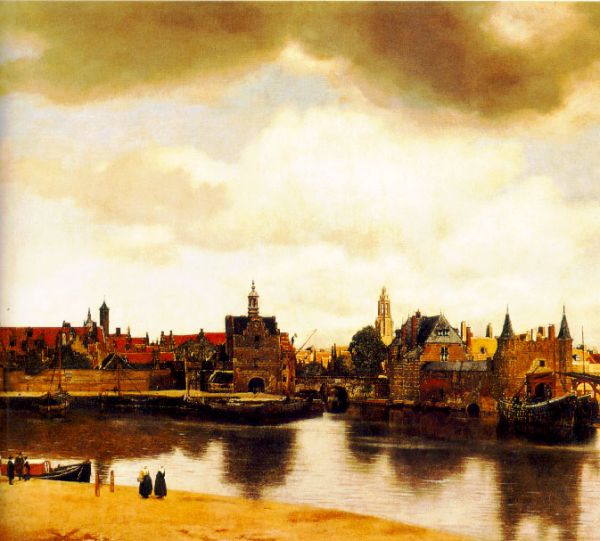
View of Delft
The Hague, Mauritshuis
99x118 1660-61
This magnificent landscape is large enough to lose oneself in, with the horizontal band of delicately painted buildings, framed by sparkling water and monumental clouds. A fourth component of the composition is the triangle of land at lower left, a device introduced into Dutch landscape art by Pieter Bruegel the Elder.
The foreground is in shadow, while the buildings at the back are in bright sunshine. The clock on the gatehouse (center), shows that it is 7am, with the clouds inevitably roiling in on a bright dawn. The red roofs at the left have a rough texture, while the sunlit background roofs are painted in a thick, undulating pattern to suggest corrugated tile. The reflections in the water are an important part of the composition; the negative space that is also important in other Vermeer paintings.
The bright church tower, just right of center, is probably a political statement. It is the Nieuwe Kerk, which holds the tomb of William of Orange, a hero of the Netherlands for his role in the resistance to Spanish rule.
It is assumed that Vermeer made this picture with the help of the camera obscura, an optical device like a pinhole camera to project a view on to a flat screen. We can only imagine the fruitful discussions with Antoni van Leeuwenhoek, the inventor of the microscope and Vermeer's friend and executor. The 1649 maps of Delft by Willem Blaeu have been used to identify the exact place -- the upper story of a house -- which is the viewpoint for this painting. It is not, however, a totally accurate representation: Vermeer compressed part of the view and spread out other parts to achieve the balanced composition.
At the right, the boat on the water shimmers with reflected light from the water, an effect achieved with tiny highlights of intensely bright, white paint. This is a slight contradiction, since the water and the boat are in shadow. This picture has always been regarded as one of Vermeer's masterpieces, and fetched the highest price (200 guilders) of any of the 21 Vermeer's that were sold in the Amsterdam auction of 1696.